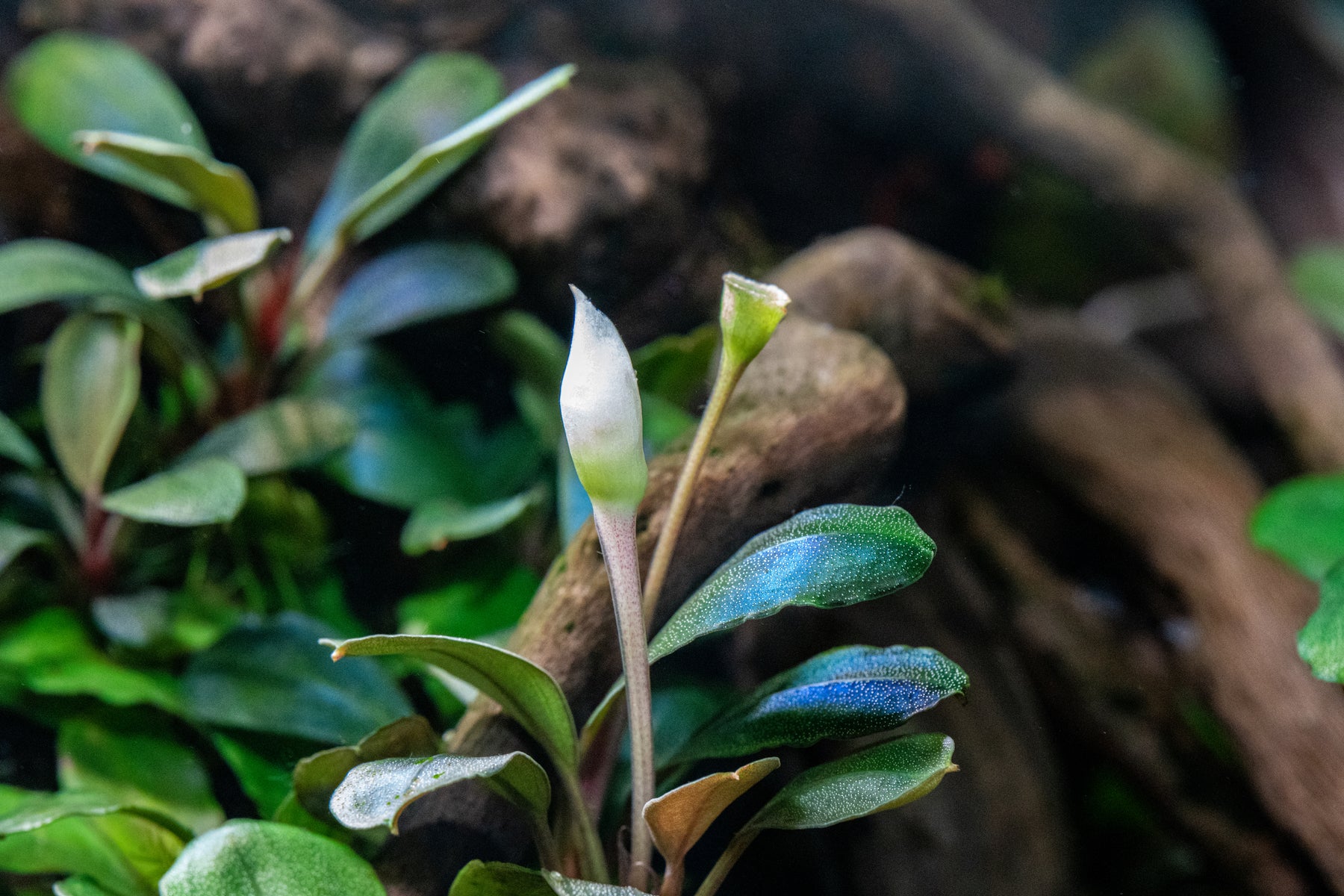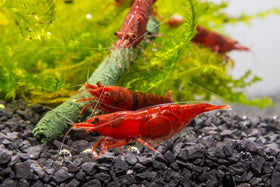
Sustainable Bucephalandra Harvesting: Balancing Conservation & Commerce
Before the rising popularity of Bucephalandra, the most common freshwater low-tech plants in the aquarium hobby were Anubias, Java Ferns, and mosses. These epiphytic* plants are low-demanding and easy to grow, making them the perfect plants for beginner aquarists.
But in the late 2000s, an exciting newcomer grabbed everyone's attention: Bucephalandra.
*Note: Plants such as Bucephalandra are commonly referred to as epiphytes in the aquascaping hobby. However, they are arguably closer to “rheophytes” as opposed to true epiphytes. Learn more about this in this article: Epiphyte or Rheophyte… Which Is It?

Pictured above is a Bucephalandra ‘Brownie Blue' leaf.
Suddenly, this new rare plant with familiar characteristics began popping up in hobbyist groups and aquarium forums. These plants feature a rhizome, like Anubias and Java Ferns, but offer a vast variety of leaf shapes and sizes. On top of that, buce leaves display a mind-blowing range of colors like red, purple, and blue. To add to their desirability, each plant has an equally amusing nickname like Dark Skeleton King, Mini Coin, and Brownie Ghost.
Specimens popped up for sale with truly impressive features and more impressive price tags. The freshwater planted hobby had found a plant that's similar to what corals are to the saltwater hobby.
The diversity and beauty they offer have resulted in bucephalandra becoming a staple plant in the aquascaping hobby.

Pictured above is Bucephalandra ‘Brownie Ghost’ 2011. This beautiful plant was one of the most sought-after species in the hobby at the time and still is today. It’s known for its striking blue and purple colors and attractive leaf shape.
An Increase in Bucephalandra Harvesting
However, as its popularity exploded, so did the harvesting from its natural habitat on the island of Borneo. Similar to Anubias, Buce grows painfully slowly and overharvesting became a concern amongst conservationists.
Southeast Asia’s ecosystems had already been of great concern by that time, and today the concern is even greater. Palm oil plantations continue to grow and spread like wildfire, substituting the fragile ecosystems that resided there before them. In addition, the proposed move of Indonesia's capital city from Jakarta to Borneo has sparked concerns about the remaining native wildlife.

A patch of mixed bucephalandra in the wild.
Hobbyists around the world are rightfully worried about the practices taking place in the harvesting, farming, and selling of bucephalandra plants. In addition, Borneo natives who make their living from Bucephalandra harvesting are concerned as well.
Some conservationists advocate for sustainably harvested buce, while others call for the end of wild Bucephalandra collection entirely. With this in mind, there are important questions to consider:
- Could numerous Bucephalandra species be lost forever due to inevitable deforestation caused by the palm oil industry? Would unknown species be lost before we've had a chance to discover them?
- How do Borneo natives harvest in a sustainable way to avoid the potential extinction of certain Bucephalandra species?
The Impact of Palm Oil Deforestation
As mentioned above, palm oil deforestation has a harmful impact on the natural habitats of many plants and animals, including Bucephalandra plants. This is a key issue that needs to be addressed. As a result, conservationists and hobbyists are working to collect and breed numerous species in order to prevent their extinction.

Pictured is a Parasphromenus bintan male juvenile alongsite Bucephalandra ‘Brownie Ghost’ 2011. The Bintan Licorice Gourami is one of the many Parasphromenus species that can be found in the aquarium trade.
There have been great success stories when it comes to preserving endangered species through breeding and reintroduction programs. The Celestial Pearl Danio and the Bangaii Cardinal Fish are two examples. Wild Betta enthusiasts are doing the same.
The Bangaii Cardinal Fish, for instance, was almost fished to extinction. However, hobbyists learned how to breed them in captivity and then released them back into the wild. As a result, their populations have improved significantly. It's a heartening example of what can be achieved when we work together to protect and conserve these precious species.
In addition, there are organizations that work to create awareness, research, and conservation actions for such situations. For example, the Parosphromenus Project is an organization that collects and breeds species like Licorice Gouramis. These species' habitats are being destroyed by the same palm oil plantations.
However, the ongoing deforestation caused by palm oil production poses a threat to the survival of Bucephalandra and other species.

Pictured is a patch of unidentified Bucephalandra in the wild.
Preventing Bucephalandra Extinction
Many criticisms have been made towards the wild collection of Bucephalandra, which stem from fears of buce extinction. While it's understandable to be concerned about extinction, there are potentially serious consequences of completely banning wild collection.
If all harvesters stop collecting Bucephalandra, we may lose the opportunity to preserve new species that have not yet been discovered to palm oil deforestation. It's a delicate balance, but one that's worth considering. If industrial farming and destruction continue, habitat loss can cause these plants to go extinct. With the added negative of us never having collected the plant, numerous species could be truly lost forever.
By following responsible wild collection practices, our suppliers only take a portion of the Bucephalandra and leave behind significant amounts. This ensures that the plant will replenish and continue to thrive in its natural habitat.

Farmed Buce Broad Green Wavy grown on one of our suppliers' farms in Thailand.
Aquatic Plant Suppliers and Their Sustainable Practices
Around 10 years ago, those harvesting Bucephalandra were likely not very concerned with the environmental impact of their actions. They might have collected and sold as much as they could without considering the long-term consequences. At that time, the plants were abundant and easy to find.
As time went on, it became apparent that their harvesting practices needed to be more sustainable. Looming extinction caused by careless harvesting would be detrimental to their lives.
Thankfully, many harvesters today are aware of the need for sustainable and responsible practices. To address the issue of overharvesting and potential extinction, many aquatic plant suppliers have found ways to harvest wild Bucephalandra sustainably.

Pictured is Bucephalandra ‘Helena.’ It has vivid colors and a pleasant round leaf shape and was first discovered and sold around 2011-2013.
Since the inception of Buce Plant, our team has always taken extra precautions before choosing a particular supplier to work with. Members of our team personally visit their farms and thoroughly inspect their operations to make sure they meet our sustainability standards.
During this process, we take the time to do our due diligence in order to make informed decisions. Our stance is that sustainable methods of harvesting are better for the environment and the long-term health of the plants.
We work with suppliers that take a limited number of plants from specific locations and ensure that the wild populations are not negatively impacted. Then, they properly replant and care for the areas they harvest from. This ensures that the plants can continue to thrive in their natural habitat. By prioritizing sustainable collection practices, we can help protect these species for the future.

Farmed stock grown at one of our suppliers' farms in Thailand. Various different species are grown atop a sandy substrate.
Farmed Bucephalandra and Tissue Culture
Farmed Bucephalandra and Bucephalandra tissue cultures are known for being the most sustainable option. However, they are much more costly to produce and purchase. This is due to the necessity of having a controlled growing environment, which takes extra time and resources. However, the investment is often worth it for its high quality.
Collectors often set up farms near the locations in which the buce plants are collected. This has the benefit of mitigating the added costs of things such as water, electricity, fertilizer, and other operation-related costs. To keep the farm-raised Bucephalandra plants healthy, they use running water straight from its source when setting up our farms.
This way, the plants are growing in conditions that are very similar to where they were originally harvested from the wild. By mimicking their natural habitat, they can minimize losses and ensure the plants stay healthy. It's just one of the ways our suppliers prioritize sustainability and conservation.
Our suppliers engage in all 3: sustainable harvesting, tissue culture production, and farming of bucephalandra. For example, they typically set aside large portions of wild-collected stock for their own farming and tissue culture operations. This helps to minimize their impact on the wild populations and promotes the long-term health and viability of the plants.
All that being said, sustainably harvested bucephalandra is arguably the most affordable option overall for hobbyists and aquascaping enthusiasts. Since the plants are not being grown in a controlled environment, the cost of production is typically lower. This allows aquatic plant suppliers to offer them at more reasonable prices.

Farmed Bucephalandra Godzilla at one of our suppliers’ farms.
Team Buce Plant's Ongoing Dedication to Sustainability
At Buce Plant, it's always been our mission to sell high-quality plants that are ethically sourced. In addition, we hope to serve our fellow hobbyists with high-quality plants (including bucephalandra) for many years to come. This is why we have always gone the extra mile to carefully choose our aquatic plant suppliers.
When Buce Plant was founded, our team carefully selected our sources for the Bucephalandra and other aquarium plants. It's important that our aquatic plant suppliers only participate in sustainable harvesting with the goal of preserving their natural environment.
Today, we offer sustainably collected, farmed, and tissue culture plants as options for all hobbyists and aquarium enthusiasts. Each of these has its own trade-offs in terms of price, portion size, and plant size.
We continue to make certain that suppliers meet the standards for being high-quality, trustworthy, and environmentally responsible. They must ensure that wild bucephalandra and their ecosystems are not harmed or destroyed by their collection practices.
Their practices help to discover and protect wild species, while also providing aquarium hobbyists with healthy and affordable options for their freshwater tanks.

Tell us - Was this article helpful? Please leave a comment below!
If you have any questions regarding this article, please DM us on Instagram, Facebook, or email support@buceplant.com so we can assist you - @buceplant





Comments
Leave a comment